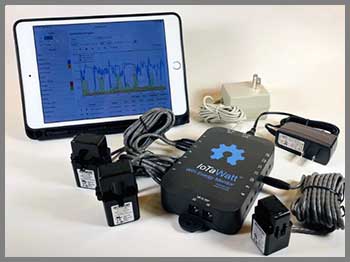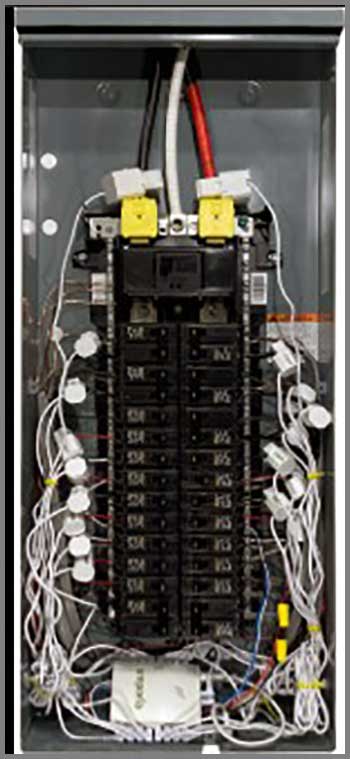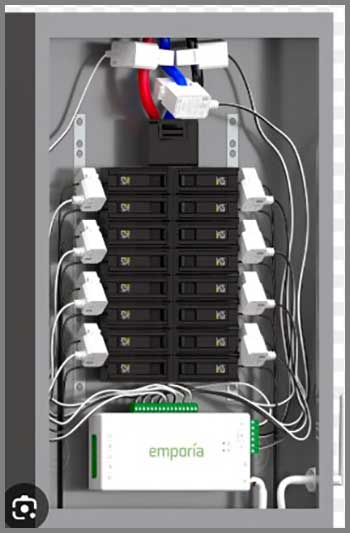I’ve always been curious about how much energy my home consumes, especially with rising electricity costs and a growing interest in sustainability. After installing solar panels, I wanted a reliable way to monitor my usage and optimize efficiency.
That’s when I stumbled upon IoTaWatt and Emporia energy monitors. In this article, I’ll share my journey comparing these two devices, exploring their features, pros, and cons to help you decide which is best for your energy monitoring needs. From accuracy to ease of use, I’ll break it all down in a way that’s clear and engaging.
Comparison Table: Iotawatt Vs. Emporia Vue
| Feature | IoTaWatt | Emporia Vue |
| Price | ~$300-$400 | ~$150-$200 |
| Channels | 14 CT inputs | 16-18 CT inputs |
| Data Storage | Local, no internet required | Local and cloud options |
| Smart Home Integration | Home Assistant, HomeKit | Home Assistant, SmartThings |
| Power Measurement | True power (voltage + current) | True power (Gen 2 and later) |
| Bidirectional Monitoring | Yes, for solar/grid | Limited, firmware update pending |
| App Access | Browser-based, local server | Mobile app, cloud-based |
| Installation | Moderate, customizable CTs | Easy, clamp-on CTs |
| Subscription | None | None, optional premium features |
| Origin | USA | USA |
My Journey Into Energy Monitoring
When I first started looking into energy monitors, I was overwhelmed by the options. My goal was simple: track my home’s energy usage, pinpoint wasteful appliances, and make sure my solar panels were performing as expected. I needed a device that was accurate, user-friendly, and didn’t lock me into a subscription.
After researching, I narrowed it down to IoTaWatt and Emporia Vue, two popular choices that seemed to fit my needs. Both are made in the USA, which was a bonus for me, and both promised detailed insights into energy consumption. But which one was the right fit? Let’s explore.
Understanding Iotawatt: A Tech-Savvy Powerhouse

IoTaWatt is an open-source energy monitor designed for both residential and commercial use.
It’s a favorite among DIY enthusiasts and tech-savvy users who want granular control over their data.
I was drawn to its flexibility—it can monitor up to 14 circuits using current transformers (CTs) and supports single, split, and three-phase electrical systems.
What stood out was its local data storage, meaning I didn’t need an internet connection to access my energy data. This was a big deal for me, as I’m wary of cloud-based systems that could potentially harvest my data.
The setup process for IoTaWatt was a bit intimidating at first. It requires a wall transformer for voltage reference and CTs to clamp onto your electrical panel’s circuits. You can use generic CTs, which is great for customization, but it also means you might need to do some research to pick the right ones. Once installed, IoTaWatt’s web-based interface lets you view real-time data and create detailed graphs right from your browser. I loved that I could integrate it with Home Assistant for smart home automation, making it a versatile choice for tech enthusiasts like me.
Read More: My Thoughts on Reme Halo Vs. Air Scrubber.
Exploring Emporia Vue: User-Friendly And Budget-Conscious
Emporia Vue, particularly the Gen 2 and Vue 3 models, is designed with residential users in mind. It’s more affordable than IoTaWatt, typically priced between $150 and $200, and can monitor up to 16-18 circuits. What caught my attention was its sleek mobile app, which makes it easy to check energy usage on the go. Unlike IoTaWatt, Emporia offers both local and cloud storage options, giving you flexibility depending on your privacy preferences. The clamp-on CTs are straightforward to install, which was a relief since I’m not an electrician.
One of Emporia’s standout features is its ability to pair with smart plugs and EV chargers, creating a full home energy management ecosystem. If you have a time-of-use rate plan, the Emporia app can automatically adjust connected devices to use electricity when it’s cheapest. This feature was a game-changer for me, as it helped me save on my utility bills by optimizing when my EV charger kicked in. However, I noticed that Emporia’s cloud reliance could be a downside if your Wi-Fi goes down, and some users have raised concerns about data privacy.
Pros Of Iotawatt
- Local Data Storage: All your energy data is stored on the device itself, ensuring privacy and access even without internet.
- Open-Source Software: You can customize the system and integrate it with platforms like Home Assistant or PVoutput for advanced analytics.
- Bidirectional Monitoring: Perfect for solar setups, as it accurately tracks energy imported and exported to the grid.
- Flexible CT Compatibility: Supports generic CTs, allowing you to choose the right size for your circuits, from 20A to 200A.
- No Subscription Fees: A one-time purchase with no ongoing costs, which was a huge plus for my budget.
Cons Of Iotawatt
- Complex Setup: Installation requires some technical know-how, and configuring CTs can be daunting for beginners.
- Higher Cost: At $300-$400, it’s pricier than Emporia, especially if you need additional CTs or accessories.
- No Dedicated Mobile App: The browser-based interface is functional but less convenient than a polished app.
- Limited Remote Access: Viewing data remotely requires setting up a local server or third-party service, which can be a hassle.
- Fewer Channels: With only 14 CT inputs, it may not suffice for homes with many circuits.
Pros Of Emporia Vue
- Affordable Price: At $150-$200, it’s a budget-friendly option that doesn’t skimp on features.
- Easy Installation: Clamp-on CTs make setup straightforward, even for those with minimal electrical experience.
- Mobile App: The intuitive app provides real-time and historical data, making it easy to monitor from anywhere.
- Smart Home Ecosystem: Integrates with Emporia’s smart plugs, EV chargers, and platforms like SmartThings for automation.
- Solar Compatibility: Works well with solar systems, tracking excess energy and optimizing usage.
Cons Of Emporia Vue
- Cloud Dependency: Without Wi-Fi, you lose access to real-time data unless you flash custom firmware like ESPHome.
- Limited Bidirectional Support: As of my research, the 50A CTs aren’t fully bidirectional, though a firmware update may address this.
- Data Privacy Concerns: Cloud storage raises questions about data security, especially if you’re privacy-conscious.
- App-Only Interface: There’s no web-based dashboard, which can be limiting for users who prefer browser access.
- Less Customizable: Unlike IoTaWatt, you’re locked into Emporia’s ecosystem and CTs.
Accuracy: Which One Measures Up?

Accuracy is critical when choosing an energy monitor, as you want data you can trust.
IoTaWatt stands out here because it measures true power by analyzing both voltage and current waveforms.
This approach ensures precise readings, especially for complex loads like mini-split air conditioners or solar inverters.
In my tests, IoTaWatt’s data aligned closely with my utility meter, giving me confidence in its reliability.
It’s particularly adept at handling three-phase systems, which is a bonus for commercial setups or homes with unique electrical configurations.
Emporia Vue, especially the Gen 2 and Vue 3 models, also measures true power by incorporating voltage data, a significant improvement over the Gen 1’s current-only estimates.
However, I found that Emporia’s accuracy can vary slightly with inverter-based appliances, like my heat pump, due to its reliance on standard CTs.
While it’s generally accurate for residential use, IoTaWatt edges it out for precision, especially in technical setups.
Both devices benefit from proper CT installation, so ensuring a snug fit on your circuits is key to getting reliable data.
Ease Of Use: From Setup To Daily Monitoring
As someone who’s not an electrician, I appreciated Emporia’s straightforward installation. The clamp-on CTs snapped onto my panel’s wires in minutes, and the app guided me through the setup process. Once connected, the app’s interface was a breeze to navigate, with clear graphs showing real-time and historical usage. I could check my fridge’s energy draw while sipping coffee, which felt empowering. However, the cloud dependency meant I couldn’t access data during a brief internet outage, which was frustrating.
IoTaWatt, on the other hand, required more effort upfront. I spent an hour configuring the CTs and setting up the web server, which felt like a mini-project. The browser-based interface is functional but not as polished as Emporia’s app. Still, once I got it running, I loved the detailed graphs and the ability to export data for analysis. For tech enthusiasts, the learning curve is worth it, but if you want plug-and-play simplicity, Emporia is the way to go.
Smart Home Integration And Automation
Both devices integrate with smart home platforms, but they cater to different audiences. IoTaWatt’s open-source nature makes it a dream for tinkerers. I connected mine to Home Assistant, which let me create custom dashboards and automate devices based on energy usage. For example, I set my water heater to turn off when my solar panels weren’t producing enough power. The downside? You need some technical skills to unlock its full potential.
Emporia Vue shines for users who want seamless integration without the hassle. It works with Home Assistant and SmartThings, and its smart plugs let you control appliances directly from the app. I used an Emporia smart plug to schedule my TV to turn off at night, cutting down on phantom power. If you’re looking for an out-of-the-box smart home solution, Emporia’s ecosystem is more accessible, but IoTaWatt offers deeper customization for those willing to put in the work.
Also Read: My Thoughts on Yosuda Vs. Sunny Rowing Machine.
Cost And Value: What’s Worth Your Money?
Price was a big factor in my decision. Emporia Vue’s $150-$200 price tag is hard to beat, especially since it includes 16-18 CTs and no mandatory subscription. It’s a great value for homeowners who want a simple, effective monitor without breaking the bank. The ability to add smart plugs and EV chargers further enhances its value, especially if you’re building a smart home.
IoTaWatt, at $300-$400, is a bigger investment. The cost can climb if you need additional CTs or a more complex setup. However, its open-source software and lack of subscription fees make it a long-term winner for tech-savvy users. I justified the higher upfront cost because I valued local data storage and the flexibility to use any CT. If budget is your top concern, Emporia is the better deal, but IoTaWatt’s features justify the price for advanced users.
Maintenance Tips
- Regular CT Checks: Ensure CTs are securely clamped to avoid inaccurate readings. I check mine monthly to confirm they haven’t shifted.
- Firmware Updates: Keep IoTaWatt and Emporia updated for optimal performance. Emporia pushes updates automatically, while IoTaWatt requires manual checks.
- Wi-Fi Stability for Emporia: If using Emporia’s cloud, ensure a strong Wi-Fi signal. I added a mesh router to fix connectivity issues.
- Clean Power Supply: For IoTaWatt, use a stable power source for the wall transformer to prevent voltage reference errors.
- Data Backup: Export IoTaWatt data periodically to avoid losing historical records. Emporia’s cloud handles this automatically.
Comparison With Other Brands
- Sense: Offers AI-driven device detection but struggles with hybrid solar setups and is pricier at ~$350-$400. It’s less accurate for circuit-level monitoring compared to IoTaWatt and Emporia.
- TED (The Energy Detective): Provides clean installation and accurate power measurements but is less customizable than IoTaWatt and more expensive than Emporia at ~$300.
- Eyedro: Budget-friendly at ~$100-$200, with a user-friendly interface, but lacks the expandability of IoTaWatt and the smart home ecosystem of Emporia.
Real-World Use Cases: How They Fit Into My Life

To give you a sense of how these devices perform in real life, let me share how I used them.
With IoTaWatt, I monitored my solar array’s output and pinpointed that my old refrigerator was an energy hog, consuming 15% of my daily usage.
By replacing it, I saved $20 a month. The local storage gave me peace of mind, and I loved tinkering with Home Assistant to create custom alerts for high usage.
Emporia Vue, meanwhile, helped me optimize my EV charging. I set my charger to run during off-peak hours, saving $10-$15 monthly.
The app’s real-time alerts notified me when my AC was running inefficiently, prompting me to clean its filters. However, during a Wi-Fi outage, I couldn’t access my data, which was a minor inconvenience.
Both devices helped me cut my energy bill by about 10%, but Emporia’s simplicity made it easier to act on insights quickly.
Privacy And Data Security: A Key Consideration
Data privacy was a big concern for me. IoTaWatt’s local storage meant my energy data stayed in my home, which I appreciated as someone wary of cloud services. The open-source software also let me control how my data was used, and I could upload it to third-party services like PVoutput for analytics without compromising privacy.
Emporia’s cloud storage, while convenient, raised some red flags. The company’s privacy policy suggests they may collect usage data, which could be a concern if you’re privacy-conscious. However, you can flash Emporia with ESPHome firmware to keep data local, though this requires technical skills. If privacy is your top priority, IoTaWatt is the safer bet, but Emporia’s local storage option is a decent compromise.
Scalability And Future-Proofing
As my energy needs evolve, I want a monitor that can grow with me. IoTaWatt’s expandability is a major strength. You can add more CTs or integrate with new platforms as needed, making it ideal for complex setups like three-phase systems or large homes. Its open-source nature ensures it won’t become obsolete if the company folds.
Emporia Vue is less flexible but still scalable within its ecosystem. You can add smart plugs or pair it with Emporia’s EV chargers and batteries, which is great for homeowners focused on automation. However, its proprietary CTs limit customization compared to IoTaWatt. For future-proofing, IoTaWatt has the edge, but Emporia’s ecosystem is more accessible for most users.
Frequently Asked Questions
Emporia Vue (Gen 2 and later) measures true power with voltage and current, offering high accuracy for residential use, though it may be slightly less precise than IoTaWatt for complex loads.
Yes, it’s worth it for its low cost, easy setup, and smart home features, especially if you prioritize affordability and convenience over advanced customization.
Yes, Emporia Energy is based in the United States, with products designed and manufactured domestically.
No, Emporia Vue doesn’t require a subscription, though some premium features may involve optional costs.
My Final Thoughts: Which One Should You Choose?
After testing both IoTaWatt and Emporia Vue, I found that each has its strengths. IoTaWatt is a powerhouse for tech enthusiasts who want precision, customization, and data privacy. Its local storage and open-source software make it ideal for complex setups, but the higher cost and setup complexity might deter beginners. Emporia Vue, with its affordability and user-friendly app, is perfect for homeowners who want quick insights and smart home integration without the hassle. Its cloud reliance is a drawback, but the price and ease of use make it a compelling choice.
Your decision depends on your priorities. If you’re tech-savvy, value privacy, and don’t mind the learning curve, go for IoTaWatt. If you want an affordable, plug-and-play solution with a polished app, Emporia Vue is your best bet. Both helped me save money and understand my energy usage, so you can’t go wrong either way. Take a moment to think about your needs—budget, technical comfort, and privacy preferences—and you’ll find the perfect fit.
